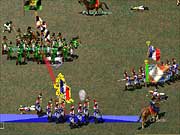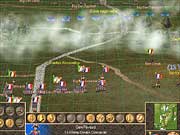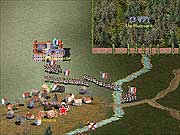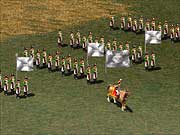BreakAway Games has made a name for itself using other developers' game engines. It created the Paradise Island expansion for PopTop's Tropico and the Cleopatra and Emperor: Rise of the Middle Kingdom games for Impressions' city-building series. But the developer cut its teeth on the engine Firaxis used for Sid Meier's Gettysburg, using it to make Sid Meier's Antietam. From there, BreakAway Games adapted the engine to the pageantry of Napoleonic warfare and created Waterloo: Napoleon's Last Battle. Now the company has polished it up even more for Austerlitz: Napoleon's Greatest Victory. The result is a testament to BreakAway's facility with the engine, as well as the brilliance of Sid Meier's basic design.

As far as Napoleon's battles go, Austerlitz isn't as well known as Waterloo, his famous last stand against the English. However, for a number of reasons, it is an ideal subject for a wargame. The battle at Austerlitz was a bold tactical victory in which Napoleon outmaneuvered and outsmarted the emperors of Austria and Russia. It was also a decisive strategic victory that cleared one of the last obstacles to France's hegemony over Europe, making it a historical linchpin. "Roll up the map of Europe," said England's prime minister, William Pitt, after the battle. "We shall not need it these seven years." Finally, it featured the armies of three nations on one battlefield, as France faced the combined armies of Austria and Russia. Austerlitz offers tactical flexibility, historical significance, and variety. It's not surprising that this is the fourth wargame to feature this battle in the last year.
The Gettysburg engine does a superlative job of simulating the warfare of the period, which is more like colliding parades than the mechanized massacres we call war these days. There's something at once quaint and spectacular about troops in gaudy uniforms, neatly lined up under big colorful banners. The gameplay comes down to moving vast numbers of men in orderly formations, subjecting them to the extreme stress of shooting at guys who are shooting back at them, and then hoping they don't break and run before the other guys. It's a classic instance of order slowly collapsing into chaos, a fitting metaphor for war itself and a much more visceral and visual approach than anything turn-based.

The engine makes it easy to control your troops and understand the mechanics at work. It's a simple matter to march whole divisions into position, wheel lines around to face a threat, and reinforce weak spots when troops take heavy fire. It's easy to see how marauding cavalry can terrorize a battlefield, how artillery can shred even the most orderly lines, and how much more deadly muskets are at 100 yards than at 200 yards. What's more, the engine always makes it clear why things are happening, which is a real accomplishment considering that it runs in real time. You'll never feel that there's some sort of unreliable random-number generator at work under the hood. You can tell exactly how close your regiments are to breaking and being routed. You can see how cavalry sneaking through woods will need to regroup before charging across a field. You can see the effect nearby leaders have and how certain terrain gives you cover from enemy fire. And there's never a sense that you're being rushed, as the game speed is flexible. You can even pause and give orders at any time.
The interface is sensibly laid out, with thorough in-game info available by right-clicking on a button. For instance, if you don't know what a mixed-order formation is or why you'd want to use it, right-clicking brings up a helpful box that answers these very questions. All commands can be issued with clearly labeled buttons or hotkeys. There are also helpful screens listing orders of battle, a log of all warning messages, and a breakdown of the current state of the battle. You can lay a grid over the map to gauge distances or check lines of sight. A setting to exaggerate elevation information makes it easy to see the high ground you'll want to occupy. When a battle is over, you get the same sort of thorough debriefings that breathed so much personality into Gettysburg. In addition to the excellent replay feature, there are detailed statistics on casualties and scoring. There are even the equivalent of MVP awards for each side's best units. Like Gettysburg, Austerlitz does a masterful job of offering all the information you need, and then some, without overwhelming you.
Although the animation isn't as choppy as it was in the Waterloo game, the game's graphics look chintzy next to state-of-the-art games like Creative Assembly's picturesque Shogun: Total War. Austerlitz's terrain is simple, and the bitmapped troops look awfully busy with all the color and detail used to re-create their distinctive uniforms and standards. There are times that Austerlitz seems like it might dissolve into visual soup if it weren't for various display filters. But if you're playing Austerlitz for the graphics, you're not just in the wrong game, you're probably in the wrong genre. As far as wargaming goes, Austerlitz looks great. It also sounds great, with the effects of shuffling men, clomping and whinnying horses, the rustle of equipment-laden soldiers, the crack of musket fire, and the boom of artillery, all varying in volume and intensity. Even the occasional shouts, including your officers responding to whatever buttons you're pressing, are convincingly dramatic and varied.

The most significant addition to the evolving Gettysburg engine is the ability to let the AI manage your troops without completely giving up control. Although you can only give the AI leaders general orders for how aggressively to attack or defend, this makes the larger scenarios much more manageable without restricting your input to one corner of the battle. In fact, this comes close to approximating one of the series' strongest features: cooperative multiplayer support. The games based on the Gettysburg engine have been ideal for multiplayer matches, but not just for going head-to-head. You can also set up a battle against the AI with you and other players dividing control of friendly troops among yourselves. Playing alongside friendly AI-controlled troops with the ability to give them general guidelines is almost like having bots in a team-based first-person shooter. When you take into account the random battles you can set up, as well as the historical variants, Austerlitz has almost unprecedented replay value for a game centered on a single battle.

There are historical nuances that make the three sides distinct, but these aren't clear until you've played quite a bit. The French have the most powerful troops, since they represent Napoleon's army in its prime. Austria's Grenz brigades are crackerjack skirmishers, as opposed to the unruly mobs of Cossacks that the Russian allies used as cavalry. But by and large, you're always playing with the three-way dynamic between infantry, cavalry, and artillery. Most of the uniqueness of Austerlitz comes out in the map, which features landmarks like the famous Pratzen Heights that dominated the center of the battle and the Sokolnitz Pheasantry, a wooded hunting preserve that served as a sort of anchor for the Russian/Austrian lines. Also prominent is the Goldbach Stream, which ran along a depression that was filled with fog during the early hours of the battle. The fog, which served as a temporary curtain dividing the battlefield into east and west, is fully modeled in the game as a type of terrain that gradually burns off as the sun rises.
Finally, BreakAway Games has included a set of comprehensive tutorials and a thorough manual to acquaint new players with the game engine. The manual includes a detailed and dramatic account of the battle, as well as descriptions of the warfare of the period. This sort of documentation is just another example of how BreakAway Games has taken pains to put together a complete package. As far as Napoleonic warfare goes, you'd be hard-pressed to find a game as visceral and polished as Austerlitz: Napoleon's Greatest Victory.